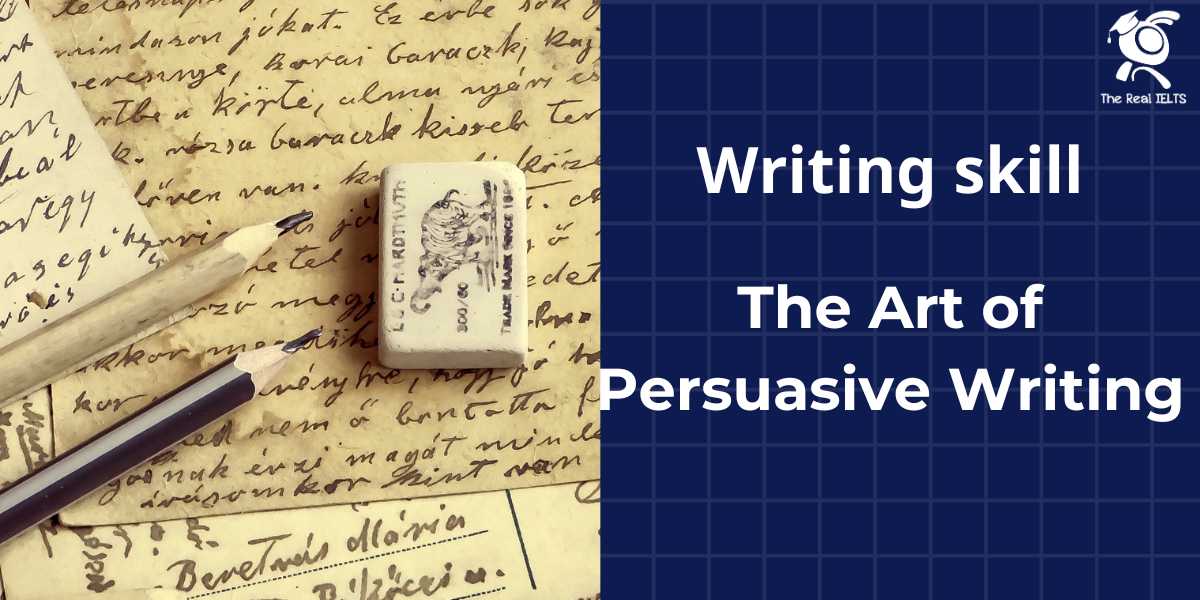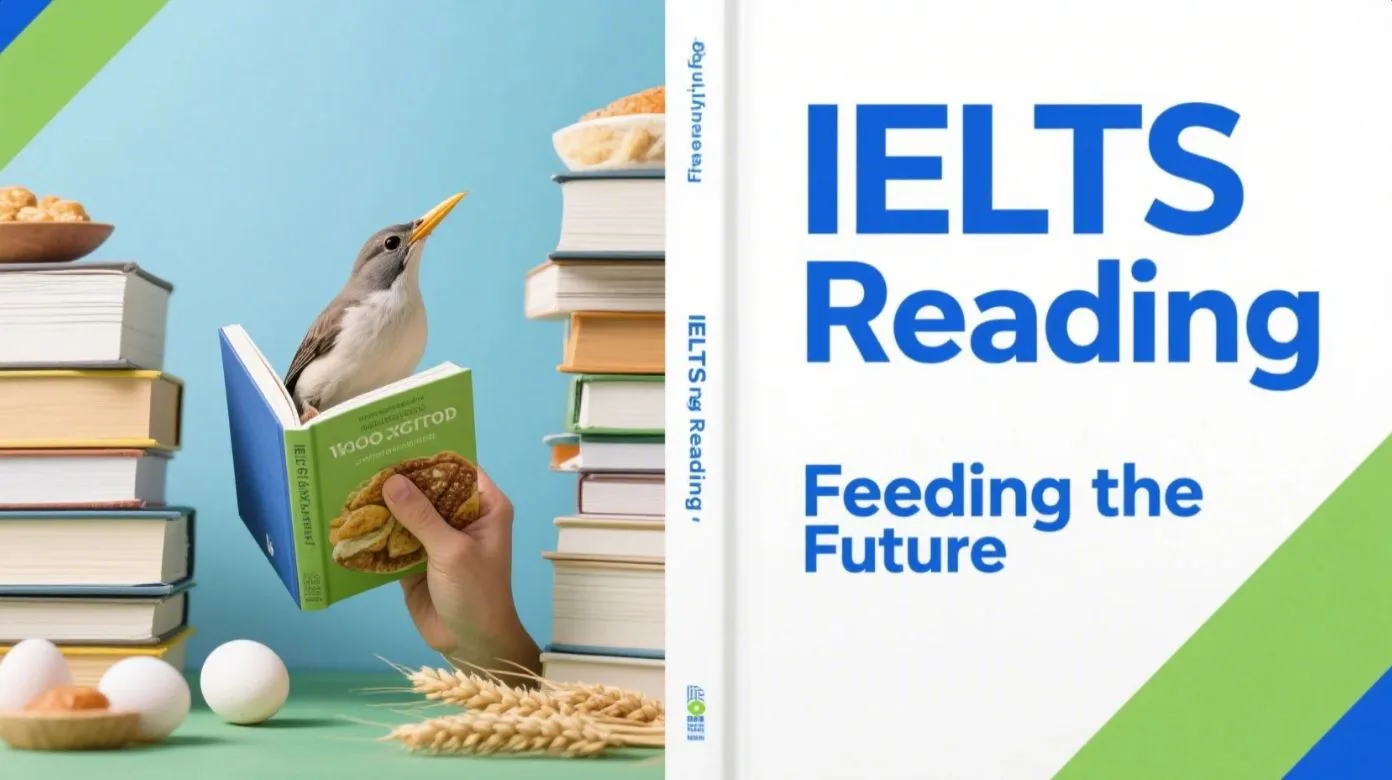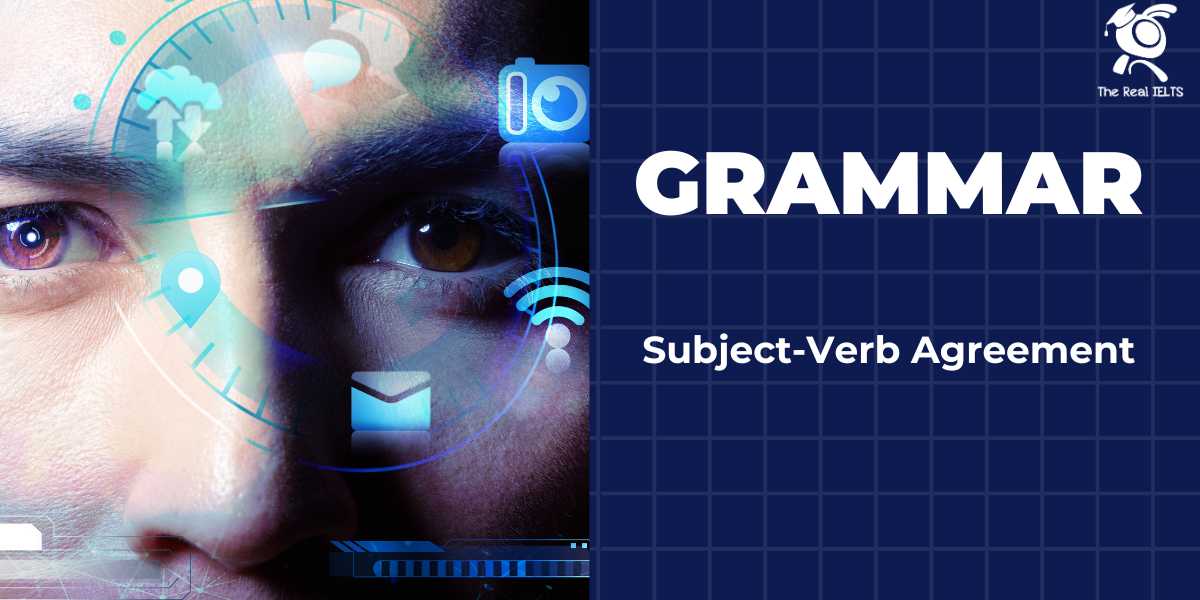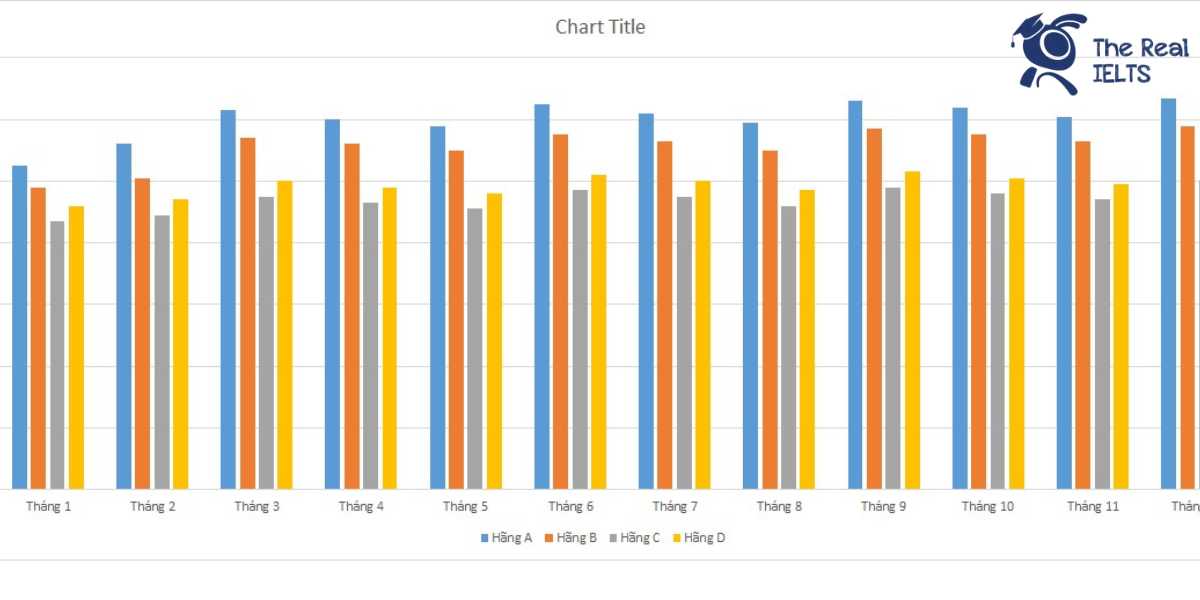Series luyện Writing Skill của The Real IELTS bài viết này có chủ đề The Art of Persuasive Writing: Crafting Compelling Arguments. Chủ đề này cũng là một chủ đề khiến rất nhiều bạn muốn để có thể nâng cao kỹ năng Writing của bản thân.
Các từ vựng cần nắm được trong bài Writing
- Persuasive [pərˈsweɪsɪv] – (adj) Thuyết phục
- Compelling [kəmˈpɛlɪŋ] – (adj) Hấp dẫn, thuyết phục
- Arguments [ˈɑːɡjəmənts] – (n) Lập luận, lý lẽ
- Intricacies [ˈɪntrɪkəsiz] – (n) Sự phức tạp, sự tinh xảo
- Captivate [ˈkæptɪveɪt] – (v) Cuốn hút, làm say mê
- Drive [draɪv] – (v) Thúc đẩy, động viên
- Narrative [ˈnærətɪv] – (n) Câu chuyện, chuyện kể
- Core [kɔːr] – (n) Lõi, trung tâm
- Viewpoint [ˈvjuːpɔɪnt] – (n) Quan điểm, quan điểm nhìn
- Specific [spɪˈsɪfɪk] – (adj) Cụ thể, đặc biệt
- Course [kɔːrs] – (n) Hướng, con đường
- Expository [ɪkˈspɑːzɪtɔːri] – (adj) Phổ biến, giảng dạy
- Clarify [ˈklærɪfaɪ] – (v) Làm sáng tỏ, làm rõ ràng
- Ambiguity [ˌæmbɪˈɡjuːɪti] – (n) Sự mơ hồ, sự mơ hồ
- Credibility [ˌkrɛdəˈbɪləti] – (n) Uy tín, đáng tin cậy
- Reputable [ˈrɛpjʊtəbl] – (adj) Có uy tín, danh tiếng
- Narrative [ˈnærətɪv] – (n) Câu chuyện, chuyện kể
- Decision-making [dɪˈsɪʒənˌmeɪkɪŋ] – (n) Quyết định, quyết định
- Weaving [ˈwiːvɪŋ] – (v) Dệt, dệt
- Culminates [ˈkʌlmɪˌneɪts] – (v) Cao điểm, cung cấp
- Directive [dɪˈrɛktɪv] – (n) Chỉ thị, chỉ dẫn
- Resonate [ˈrɛzəˌneɪt] – (v) Gây ấn tượng, ảnh hưởng
- Potent [ˈpoʊtnt] – (adj) Mạnh mẽ, mạnh mẽ
- Navigating [ˈnævɪˌɡeɪtɪŋ] – (v) Định vị, điều hướng
- Interconnected [ˌɪntərkəˈnɛktɪd] – (adj) Kết nối, liên kết
Dàn ý triển khai bài Writing
The Art of Persuasive Writing: Crafting Compelling Arguments
Introduction:
- Briefly introduce the importance of persuasive writing in various aspects of life, from academic essays to business proposals.
- Highlight the power of compelling arguments in influencing opinions and decisions.
Understanding Persuasive Writing:
- Define persuasive writing and its purpose: to convince readers to adopt a particular viewpoint or take a specific action.
- Discuss the difference between persuasive and expository writing, emphasizing the role of persuasion in influencing reader behavior.
Key Elements of Compelling Arguments:
- Clarity and Conciseness:
- Explain the importance of clarity in expressing ideas and arguments.
- Discuss techniques such as using simple language, avoiding jargon, and organizing thoughts logically to enhance clarity.
- Credibility and Authority:
- Stress the significance of establishing credibility as a writer.
- Discuss strategies for building credibility, including citing reputable sources, providing evidence, and acknowledging counterarguments.
- Emotional Appeal:
- Explore the role of emotions in persuasive writing.
- Discuss techniques such as storytelling, using vivid imagery, and appealing to readers’ values and emotions to strengthen arguments.
- Logical Reasoning:
- Highlight the importance of sound logic and reasoning in persuasive writing.
- Explain the use of evidence, examples, and logical fallacies to support arguments and counter opposing viewpoints.
- Call to Action:
- Emphasize the need for a clear and compelling call to action.
- Discuss effective ways to motivate readers to take the desired action, such as using persuasive language and providing incentives.
Crafting Compelling Arguments:
- Provide practical tips for crafting persuasive arguments, including:
- Conducting thorough research to gather evidence and supporting data.
- Anticipating and addressing potential objections or counterarguments.
- Tailoring arguments to appeal to the specific audience’s interests, values, and concerns.
Examples of Persuasive Writing:
- Present real-life examples of persuasive writing in various contexts, such as:
- Political speeches
- Advertising campaigns
- Opinion editorials
- Marketing content
Conclusion:
- Summarize the key points discussed in the article.
- Reinforce the importance of mastering the art of persuasive writing in effectively communicating ideas and influencing others.
- Encourage readers to apply the techniques and principles learned to enhance their own persuasive writing skills.
References:
- Provide a list of references or recommended reading materials for further exploration of the topic.
Bài viết triển khai
The Art of Persuasive Writing: Crafting Compelling Arguments
Introduction: Persuasive writing is a potent tool that influences opinions, drives decisions, and shapes narratives. Whether it’s a political speech rallying supporters, a marketing campaign enticing consumers, or an academic essay swaying readers to a new perspective, the art of persuasive writing holds immense power. In this article, we delve into the intricacies of crafting compelling arguments that captivate audiences and drive action.
Understanding Persuasive Writing: At its core, persuasive writing aims to convince readers to embrace a particular viewpoint or take a specific course of action. Unlike expository writing, which primarily informs or explains, persuasive writing seeks to persuade, leveraging language, evidence, and emotion to sway opinions.
Key Elements of Compelling Arguments:
- Clarity and Conciseness: To effectively persuade, clarity is paramount. Using straightforward language and organizing ideas logically ensures that readers comprehend the message without confusion or ambiguity.
- Credibility and Authority: Establishing credibility as a writer is crucial for garnering trust and respect from the audience. Citing reputable sources, providing evidence, and acknowledging opposing viewpoints are essential strategies for bolstering credibility.
- Emotional Appeal: Emotions play a significant role in decision-making. By weaving narratives, employing vivid imagery, and appealing to readers’ values and emotions, persuasive writers can forge strong connections and elicit desired responses.
- Logical Reasoning: Sound logic forms the backbone of persuasive arguments. Supporting claims with evidence, employing logical reasoning, and avoiding fallacies strengthen the persuasiveness of the writing and enhance its credibility.
- Call to Action: Every persuasive piece culminates in a call to action—a clear directive urging readers to take the desired steps. Crafting a compelling call to action requires persuasive language, clarity, and a deep understanding of the audience’s motivations.
Crafting Compelling Arguments: To craft persuasive arguments effectively, writers must conduct thorough research, anticipate objections, and tailor their message to resonate with the audience’s interests and concerns. By employing these strategies, writers can create persuasive content that resonates with readers and incites action.
Examples of Persuasive Writing: From Martin Luther King Jr.’s iconic “I Have a Dream” speech to Nike’s “Just Do It” advertising campaign, persuasive writing permeates various aspects of society. Political speeches, advertising campaigns, opinion editorials, and marketing content all exemplify the power of persuasive writing in shaping attitudes and behaviors.
Conclusion: Mastering the art of persuasive writing is a formidable skill that empowers individuals to communicate effectively, influence opinions, and drive change. By embracing clarity, credibility, emotional appeal, logical reasoning, and compelling calls to action, writers can craft arguments that captivate audiences and inspire action. As we continue to navigate an increasingly interconnected world, the ability to persuade with words remains a potent tool for effecting positive change.
References:
- Adams, E. (2017). Words That Work: It’s Not What You Say, It’s What People Hear. Crown Publishing Group.
- Perloff, R. M. (2018). The Dynamics of Persuasion: Communication and Attitudes in the 21st Century. Routledge.
- Pink, D. H. (2012). To Sell Is Human: The Surprising Truth About Moving Others. Riverhead Books.
Các cấu trúc ngữ pháp được sử dụng trong bài viết
- Infinitive phrases:
- “To effectively persuade”
- “To craft persuasive arguments”
- “To sway opinions”
- “To take the desired steps”
- Gerunds and gerund phrases:
- “Establishing credibility as a writer”
- “Crafting a compelling call to action”
- Participial phrases:
- “Leveraging language, evidence, and emotion”
- “Using straightforward language and organizing ideas logically”
- “Supporting claims with evidence, employing logical reasoning, and avoiding fallacies”
- “By employing these strategies”
- Prepositional phrases:
- “In various aspects of life”
- “Of crafting compelling arguments”
- “In influencing opinions and decisions”
- “For bolstering credibility”
- “With words”
- Relative clauses:
- “That influences opinions, drives decisions, and shapes narratives”
- “Which primarily informs or explains”
- “That resonates with readers and incites action”
- “That empowers individuals to communicate effectively, influence opinions, and drive change”
- Modal verbs:
- “Can influence”
- “Must conduct”
- “Can create”
- Passive voice:
- “Persuasive writing is a potent tool”
- “Credibility as a writer is crucial”
- “Persuasive writing permeates various aspects of society”
- “The ability to persuade with words remains a potent tool”
- Comparative structures:
- “More interconnected world”
- “Increasingly interconnected world”
- Conditional sentences:
- “If it’s a political speech rallying supporters, a marketing campaign enticing consumers, or an academic essay swaying readers to a new perspective”
- Coordinating conjunctions:
- “And” used for listing multiple elements in a series, such as “clarity, credibility, emotional appeal, logical reasoning, and compelling calls to action”
- Subordinating conjunctions:
- “Whether it’s” introducing a conditional clause
- “As we continue” introducing a concessive clause
- Demonstrative pronouns:
- “This article”
- “These strategies”
- Personal pronouns:
- “We”
- “You”
- “Our”
- “Its”
- Interrogative pronouns:
- “What people hear”
- Articles:
- “A” used before singular countable nouns, such as “a potent tool” and “a clear directive”
- “The” used before specific nouns, such as “the audience’s motivations” and “the desired steps”
- Adjectives and adjectival phrases:
- “Clear and concise”
- “Compelling arguments”
- “Desired responses”
- “Thorough research”
- “Reputable sources”
- “Opposing viewpoints”
- “Strong connections”
- “Desired steps”
- “Real-life examples”
- Adverbs:
- “Effectively”
- “Crucially”
- “Bolstering”
- “Vividly”
- “Essentially”
- “Potentially”
Học lại bài viết cũ: Writing skill part 5: Analyzing the Role of Social Media in Society.















